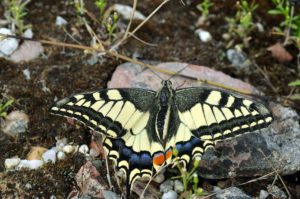- Hardcover : 768 Seiten
- Verlag: Springer India
- Autor: Bir Bahadur
- Auflage: 1. Auflage, erschienen am 30.06.2015
- Sprache: Deutsch
- ISBN-10: 81-322-2282-2
- ISBN-13: 978-81-322-2282-8
- Größe: 25,4 x 17,8 cm
- Gewicht: 17961 Gramm
Plant Biology and Biotechnology
Autoren: Bir Bahadur267,49 €

HONIGHÄUSCHEN (BONN) – Plant genomics and biotechnology have recently made enormous strides, and hold the potential to benefit agriculture, the environment and various other dimensions of the human endeavor. It is no exaggeration to claim that the twenty-first century belongs to biotechnology. Knowledge generation in this field is growing at a frenetic pace, and keeping abreast of the latest advances and calls on us to double our efforts. Volume II of this two-part series addresses cutting-edge aspects of plant genomics and biotechnology. It includes 37 chapters contributed by over 70 researchers, each of which is an expert in his/her own field of research.Biotechnology has helped to solve many conundrums of plant life that had long remained a mystery to mankind. This volume opens with an exhaustive chapter on the role played by thale cress, Arabidopsis thaliana, which is believed to be the Drosophila of the plant kingdom and an invaluable model plant for understanding basic concepts in plant biology. This is followed by chapters on bioremediation, biofuels and biofertilizers through microalgal manipulation, making it a commercializable prospect; discerning finer details of biotic stress with plant-fungal interactions; and the dynamics of abiotic and biotic stresses, which also figure elsewhere in the book.Breeding crop plants for desirable traits has long been an endeavor of biotechnologists. The significance of molecular markers, marker assisted selection and techniques are covered in a dedicated chapter, as are comprehensive reviews on plant molecular biology, DNA fingerprinting techniques, genomic structure and functional genomics. A chapter dedicated to organellar genomes provides extensive information on this important aspect. Elsewhere in the book, the newly emerging area of epigenetics is presented as seen through the lens of biotechnology, showcasing the pivotal role of DNA methylation in effecting permanent and transient changes to the genome. Exclusive chapters deal with bioinformatics and systems biology. Handy tools for practical applications such as somatic embryogenesis and micropropagation are included to provide frontline information to entrepreneurs, as is a chapter on somaclonal variation.Overcoming barriers to sexual incompatibility has also long been a focus of biotechnology, and is addressed in chapters on wide hybridization and hybrid embryo rescue. Another area of accomplishing triploids through endosperm culture is included as a non-conventional breeding strategy. Secondary metabolite production through tissue cultures, which is of importance to industrial scientists, is also covered.Worldwide exchange of plant genetic material is currently an essential topic, as is conserving natural resources in situ. Chapters on in vitro conservation of extant, threatened and other valuable germplasms, gene banking and related issues are included, along with an extensive account of the biotechnology of spices the low-volume, high-value crops. Metabolic engineering is another emerging field that provides commercial opportunities. As is well known, there is widespread concern over genetically modified crops among the public. GM crops are covered, as are genetic engineering strategies for combating biotic and abiotic stresses where no other solutions are in sight. RNAi- and micro RNA- based strategies for crop improvement have proved to offer novel alternatives to the existing non-conventional techniques, and detailed information on these aspects is also included. The books last five chapters are devoted to presenting the various aspects of environmental, marine, desert and rural biotechnology. The state-of-the-art coverage on a wide range of plant genomics and biotechnology topics will be of great interest to post-graduate students and researchers, including the employees of seed and biotechnology companies, and to instructors in the fields of plant genetics, breeding and biotechnology.
Über „Plant Biology and Biotechnology“
Das vorliegende Sachbuch zu Themen aus Umwelt und Natur „Plant Biology and Biotechnology“ wurde erarbeitet und verfasst von Bir Bahadur. Dieses Sachbuch erschien am 30.06.2015 und wurde herausgegeben von Springer India.
Bücher wie „Plant Biology and Biotechnology“ sind im Onlineshop des Honighäuschens bestellbar. Online bestellte Fachbücher zur Imkerei und zu anderen Themen der Umwelt und des Artenschutzes sind zu den üblichen Öffnungszeiten auch direkt im Buchladen Bundesamt für magische Wesen in Bonn, der Stauhauptstadt von Nordrhein-Westfalen abholbar und werden auf Wunsch verschickt.
Das Thema Bienensterben, Rückgang von Insekten und allgemeines Artensterben ist in aller Munde und das Honighäuschen als frühere Bioland Imkerei hat sich von Anfang an daran beteiligt. Mehr als 35 Jahre Imkereierfahrung nahmen ihren Anfang 1982 mit den ersten eigenen Bienen.

Der zehnjährige Junge, der 1977 einem Hamburger Imker über die Schulter schaute; der Fünfzehnjährige, der mit der Imkerei in Zeiten begann, in denen es noch keine Varroamilbe gab; der achtzehnjährige Fahrschüler, der lernte, dass man die Windschutzsscheibe seines Autos nach einer längeren Fahrt von Insekten säubern muß; der zwanzigjährige Student, der für seine Bienen einen Platz in Bonn suchte; der dreißigjährige Berufsimker, der seinen Bienen quasi eine Gutenachtgeschichte erzählte und sich den Kopf zerbrach, wie man die Umwelt mit ihren Bienen, Wespen, Schmetterlingen und andere blütenbesuchenden Insekten vor den Machenschaften der Agrargiftindustrie und der Gleichgültigkeit agrarindustriehöriger Politiker schützt; der Imker, der nicht nur auf dem Weihnachtsmarkt Bonn die Öffentlichkeit suchte, um bei Führungen an den Bienen auf dem Dach der Bundeskunsthalle zu erleben, dass Kinder (und deren Helikoptermuttis!) Angst vor Schmetterlingen hatten, bis hin zum Begleiter von Forschungsprojekten zu den Riesenhonigbienen Nepals oder den Killerbienen Afrikas, stellt fest, dass etwas sehr im Argen liegt in unserem Umgang mit der Umwelt.
Es sollte jedem bewußt sein, dass die Haltung „Natur ja, aber bitte woanders!“ nicht in Ordnung ist. Machen wir so weiter, werden wir Insekten und andere Tiere irgendwann nur noch in Foto- und Bildbänden finden.
Die wunderschöne Welt der Natur

In unserem Online-Buchshop finden Sie viele Bücher wie „Plant Biology and Biotechnology“, die Ihnen die fantastische Welt der Bienen, Wespen, Ameisen, Hornissen und Schmetterlinge sowie anderer Insekten näherbringen.
Aber nach wie vor stehe ich Ihnen auch gern zu einem Gespräch oder zu einer Beratung im Umgang mit Bienen, Wespen, Hornisse, Wildbienen und Hummeln zur Verfügung, wenn Sie Fragen haben. Besuchen Sie uns in Bonn im Bundesamt für magische Wesen.
Und natürlich gibt es auch weiterhin Honig, Bienenwachskerzen und Met bei uns und zwar das ganze Jahr – nicht nur zu Weihnachten.
| Gewicht | 17961 g |
|---|---|
| Größe | 25,4 × 17,8 cm |





Bewertungen
Es gibt noch keine Rezensionen